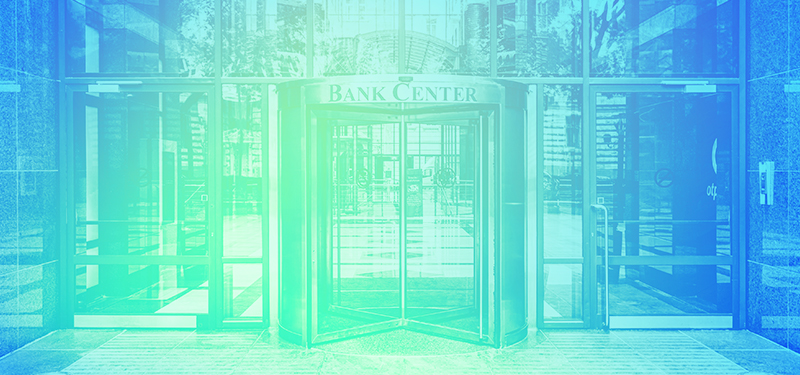Embracing Omnichannel Financial Services for the Digital 2.0 Economy

Advanced networking technology to bridge the generational gap and diverse customer base, delivering the experience all customers want.
It’s no secret that to succeed in the financial services sector, organizations must deliver an optimized, secure customer experience. Yet in today’s Digital 2.0 Economy, the secret sauce for successful financial services firms will be delivering the omnichannel experience demanded by customers—from baby boomers to Generation Z.
Banking has evolved from the famous notion of bankers’ hours to conducting end-to-end banking all from the convenience of a smartphone. Savvy financial services firms will want to keep the loyal branch visitors and the emerging virtual bankers happy by making the right physical resources available in the right locations at the right times. They will also be aware of the need to keep a secure infrastructure available to mobile and online bankers logging on at all hours from around the world.
“Banking is a 24-7-365 service industry. Customers want security and ease-of-use. They also need to know that it is always accessible to them,” says Thomas Sweeney, Exec. Director, Strategic Client Group, Product Sales, Comcast Business. “It can never be a situation in which banking services cannot be accessed.”
Delivering the seamless omnichannel experience customers expect requires a solid infrastructure to support fluctuating demand and flexible services. And any technologies deployed in the financial services industry must also address security and compliance requirements—on both the client side and in the financial organizations’ back-office. Simply put, the financial services industry must invest in and adopt sophisticated, innovative technologies to wow existing customers while attracting (and retaining) new generations of consumers.
A Generational Guide
Financial services is an industry that spans all generations, which puts firms in that sector in the unique position to create products and services for a diverse group of customers.For instance, according to the U.S. Bureau of Labor Statistics1, millennials will constitute roughly 44% of the U.S. workforce by 2022, as baby boomers continue to represent a significant part of the workforce. By 2024, baby boomers will have reached ages 60 to 78. And some of them are expected to continue working even after they qualify for Social Security retirement benefits, according to the U.S. Bureau of Labor Statistics reports.2 Gen X makes up about one-third of the U.S. workforce, according to data from Pew Research3 and the upcoming Gen Z should not be discounted. According to The Center for Generational Kinetics4, 77% of people ages 14 to 21 are currently earning their own spending money, much like their older counterparts.
While baby boomers are often considered to be brand loyal, the same is not the case for millennials, who have already garnered a reputation for being willing to switch service providers based on an unsatisfactory customer experience. One generation needs a face-to-face interaction to establish trust; another generation prefers secure anonymity online while conducting their business. And all customers from every generation need cost-effective, secure banking that is easy to use and accessible to them. Baby boomers adopting new products and services could equate to as much as $82 billion in additional deposits and $443 billion in additional investable assets, according to data from the American Bankers Association.5
“The large retail banks are at a crossroads when it comes to their client base, which is why banks are working hard today to resonate with a new demographic while also meeting the needs of established customers,” Sweeney explains.
Essentially, financial services firms must work against competitors to attract customers from a wide range of consumers with money to manage, save and invest. Now is the time for financial services organizations to digitally evolve their business models and technology environments to support virtually anything this vast pool of customers could want, before they even ask for it.
Millennials are 3 times more likely to open an account via their phone than in person, and 67% of millennials want digital budgeting tools from their bank, according to data from the American Bankers Association.6
Omnichannel for the Masses
In the world of banking, it is not guaranteed that if you build it, they will come. Despite a bank’s best aesthetic efforts, in-branch perks, and alternative hours, a majority of customers still might not use the physical bank for their services—but some will only do their banking at the bank.
How should organizations strike this balance between supporting physical locations and providing the optimal virtual resources? Coupled with a full digital transformation, banks will have to build an omnichannel business that tackles in-branch, online, and mobile transacting. This omnichannel approach to serve diverse and disparate customers will require sophisticated software on the back-end to provide a frictionless experience to customers on the front-end.
“Financial institutions realize that to appeal to a broad customer base they need to provide stability, security and performance across all transactions,” Comcast’s Sweeney says. “It’s customer experience; it’s digital experience. Banking is a changing business highly influenced by technology, and organizations need a trusted partner to bring the solutions for their clients.”
For some, the customer demands will include an aesthetic update to the look and feel of the actual branch. From café concepts to Apple-store like banking experiences, financial institutions are evolving how they build a branch to appeal to all types of customers.
Firms such as Bank of America very publicly have opened tellerless branches featuring video-enabled ATMs to support customer-staff interactions. Others such as Eastern Bank have introduced the concept of the micro-branch to maximize customer service in small spaces. Mobile pop-up branches have also emerged as financial organizations consider the kiosk a good model to deliver services customers want while keeping costs lower. And Capital One Cafés boast the experience of a coffee house atmosphere in which customers and others are welcome to relax and maybe conduct banking business.
CIOs in 11 of the 15 industries taking part in a recent Gartner survey ranked digital business/digital transformation as one of their top three business priorities for 2018, and 23% of financial services CIOs ranked it as their No. 1 business objective.7
It’s ALL About the Apps
Financial services organizations and institutions must be providing their products and services on mobile apps to remain relevant today and into the future.
From mobile access to account information to mobile deposits and money transfers, the landscape for apps is growing and if a financial firm doesn’t have a mobile-first approach to services it will most certainly be left behind. According to the J.D. Power 2018 U.S. Banking App Satisfaction Study8, 43% of bank customers used their mobile app in the three months prior to the survey, proving mobile has become a critical interaction channel for the financial services industry.
Customers turning to mobile first should also drive financial firms’ developers to considering the smartphone, tablet, or other mobile device as a crucial platform for their products. The same J.D. Power study found that the more end users can do on the mobile app, the more they use it. High-functionality is key to impressing clients, so financial firms must consider including more well-designed, user-friendly features such as two-factor authentication security logins, chat, account management, and more.
According to the American Bankers Association, nearly one-quarter of the desirable generation of millennials point to the “lack of a mobile app as the main barrier to bank engagement,” and more than 60% say that mobile apps have enabled better tracking and spending of their finances.9 The push to mobile is here, and banks that aren’t focusing development dollars there will be left behind. Mobile apps aside, many organizations are looking to intelligent apps to equip their bank locations with next-generation technologies. Take, for instance, the premise of the smart teller, which is gaining steam across branch banking. According to branch banking research10, some 85% of financial services firms are building digital into their branches and 65% are creating interactive experiences. These experiences could combine the branch experience with a virtual assistant, providing the best of both worlds for a diverse customer base.
In fact, nearly 70% of millennials fully expect the way they “access their money will be totally different in 5 years.”11 And more than half of those millennials polled don’t think their bank offers anything unique.12
Innovation on the Financial Horizon
While the push to mobile apps is in full swing across financial organizations and their customers, a handful of other technologies could further shift the landscape in the coming months and years.
Despite the seemingly negative perception of those statistics, they actually represent an opportunity for financial institutions to wow existing and potentially new, loyal customers. For instance, while mobile pay isn’t news, it is not yet used mainstream.
Mobile pay falls under the umbrella of apps and technologies that enables individuals to connect their accounts to their smartphones for secure, quick, and simple transactions. If banks have not yet equipped their customers with the capabilities to do this, 2019 might be the watershed year for this trend.13
Artificial intelligence is another technology gaining momentum across vertical industries, but in financial services in particular, automated wealth managers or “robo-advisors” offer clients the advice and guidance they need around their finances with very little human intervention.13 These robo-advisors use algorithms around risk management and desired returns to calculate and advise how people should invest their money.
Machine learning around big data—most financial institutions house more data than any human could process in multiple lifetimes—would help banks provide clients with more insights into how to manage their money, avoid losses, and maintain a positive growth profile. The potential around big data and banking is virtually limitless. Among the applications of big data learning that financial institutions could tap are: discerning spending habits among clients; Identifying and managing risk; detecting and preventing fraud; monitoring for and aligning to compliance regulations14; and the list goes on as more data is collected.
The Science Behind SD-WAN
To support banking today and into the future, financial institutions need a new way to deliver products and services across their complex, distributed infrastructure. Enter software-defined networks for the wide-area network, or more simply put SD-WAN.
Complex network infrastructure can be more simply managed using software-defined technologies. Simpler to say, perhaps, but so sophisticated in what this type of technology can do for an established or upstart financial institution. SD-WAN will enable organizations to flex resources as they are needed, where they are needed.
Specifically, software-defined networking and software-defined wide area networks can reduce dependence on hardware and simplify complex data networks, giving administrators the ability to manage multiple sites from one central location.
SD-WAN also can support the adoption of high-speed broadband networks to handle the data and speed loads of next-generation technologies at every location.
This technology can make it significantly easier for a network administrator to manage a large and complex network with many different locations on the edge, while also providing visibility into the health of the distributed network.
Considering the growing bandwidth needs of the WAN, cost considerations, and the need to maintain the security and reliability of connections, it is not a surprise that 83% of survey respondents believe that digital transformation will require a re-architecture of the WAN.15
Here are a few key benefits to adopting SD-WAN:
Improved performance
Intelligent routing and application visibility help to reduce latency and increase application response times.
Centralized Management
Greater flexibility to push network changes across sites can shorten IT deployment cycles and reduces truck rolls.
Tighter Control
Simplified VPN, network segmentation, and policy enforcement increase the chances of your branch data remaining secure.
Optimize Investments
Reduction of expensive hardware and T1 transport can save OPEX and CAPEX. Hybrid WAN solutions can preserve your existing MPLS investment while building a path to the future.
SD-WAN is not the only option to accelerate the next phase of digital transformation for banks and other financial institutions.
They can also leverage virtual and physical private Ethernet connectivity to ensure there are no issues with network performance and no downtime in availability for critical applications at all distributed locations. They can also opt to gain this connectivity via manage services, such as managed connectivity, Wi-Fi, security, voice and business continuity.
What to do now?
Financial services organizations today need to think about the many opportunities the diverse audience of clients poses to them. How should these firms proceed into a technologically advanced future with customers wanting a full range of services from in-branch, personal touches to online functionality requiring little human interaction.
Here are a few steps toward moving digital transformation efforts from today’s standard operating procedures to tomorrow’s innovative business model:
- Invest in the technology infrastructure.
Without a solid foundation to support the diverse services needed to keep pace with digital natives and an always-evolving customer base, financial organizations won’t see great success with existing customers or attract new clients. SD-WAN enables organizations to flex when needed and allocate resources elsewhere when demand is lighter.
Implementing an intelligent infrastructure with smart software-defined networks will propel the financial services business to the next level by giving employees the resources they need anywhere to fulfill the demands of varying demographics.
- Consider and understand the customer.
Not all clients want or need the same services from their financial organizations. Create an agile environment that can allow the business to be nimble enough to adapt when customer demand changes. A diverse network that supports both remote branches, in-store presence, online banking, and mobile apps will appeal to many and allow financial organizations to specialize when customer demand requires it. Partner with a vendor that under- stands the finance industry and can allow ease-of-use, ease-of-management, high-quality functionality, and leading-edge capabilities.
- Look to the future.
What will technology bring to the future of banking? Maintaining a competitive edge in any business requires staying ahead of trends, being able to see what’s coming. Advanced biometric security scans, human-machine interactive, predictive analytics, and more could become mainstream technology in the very near future. Continue to explore how the business could enable more for its customers by adopting the tools needed to grow as they do. Technology changes quickly, and financial services organizations should keep pace to ensure their customer base is enjoying all the benefits available to them.
The financial services sector enjoys a large pool of customers upon which to build a successful business: everyone wants to better manage their money. Yet the preferred method in which they do this will vary across generations. This gives established financial institutions an advantage against upstarts; they have years of experience delighting customers with their banking. Still a new generation might not consider this experience relevant to them so there is no room for complacency.
“Retail banking customers are smarter today than ever, and they want more options and more access to information. Banks and financial institutions are modernizing their approach to how they service their clients,” Comcast’s Sweeney says. “Things that weren’t even thought of five years ago are considered commonplace today. There are more major game changers on a short horizon. And this industry knows it.”
Savvy financial services firms know this and are today investing in the technology foundation they need to support a business that can span and survive generations. A strategic investment in intelligent technology today will become a reward in business longevity tomorrow.
[1] “Millennials are the largest generation in the U.S. labor force,” Pew Research Center, April 2018
http://www.pewresearch.org/fact-tank/2018/04/11/millennials-largest-generation-us-labor-force/
[2] “Older workers: Labor force trends and career options,” U.S. Bureau of Labor Statistics, May 2017
https://www.bls.gov/careeroutlook/2017/article/older-workers.htm
[3] “Millennials are the largest generation in the U.S. labor force,” Pew Research Center, April 2018
http://www.pewresearch.org/fact-tank/2018/04/11/millennials-largest-generation-us-labor-force/
[4] “The State of the Gen Z 2017: Meet the Throwback Generation,” The Center for Generational Kinetics, April 2017
https://genhq.com/wp-content/uploads/2017/04/The-State-of-Gen-Z-2017-White-Paper-c-2017-The-Center-for-Generational-Kinetics.pdf
[5] “Banking the Boomers,” American Bankers Association, 2017
https://www.aba.com/Engagement/Documents/2017_BankingtheBoomers.pdf
[6] “Millennials and Banking,” American Bankers Association, 2017
https://www.aba.com/Tools/Infographics/Pages/Infographic-MillennialsBanking.aspx
[7] “Is Digital a Priority for Your Industry?,” Laurence Goasduff, Gartner blog, March 2018,
https://www.gartner.com/smarterwithgartner/is-digital-a-priority-for-your-industry/
[8] “Banking and Credit Card Apps Set New Standard for Mobile Customer Satisfaction, J.D. Power Finds,” June 2018
https://www.jdpower.com/business/resource/us-banking-mobile-app-satisfaction-study
[9] “Millennials and Banking,” American Bankers Association, 2017
https://www.aba.com/Tools/Infographics/Pages/Infographic-MillennialsBanking.aspx
[10] “Branch Transformation 2017,” Codigo, 2017
https://system.na2.netsuite.com/core/media/media.nl?id=14586&c=4634047&h=76b990158cb8b185d382&_xt=.pdf
[11] “Millennials and Banking,” American Bankers Association, 2017
https://www.aba.com/Tools/Infographics/Pages/Infographic-MillennialsBanking.aspx
[12] Ibid.
[13] Robo-advisor, Wikipedia, February 2019
https://en.wikipedia.org/wiki/Robo-advisor
[14] “Big Data analytics in the banking sector,” Medium, May 2018
https://medium.com/datadriveninvestor/big-data-analytics-in-the-banking-sector-b7cb98d27ed2
[15] “SD-WAN: Enabling the Enterprise to Overcome Barriers to Digital Transformation,” IDC, October 2017
https://cbcommunity.comcast.com/community/browse-all/details/sd-wan-enabling-the-enterprise-to-overcome-barriers-to-digital-transformation
In today’s Digital 2.0 Economy, the secret sauce for success financial service firms will be delivering the omnichannel experience demanded by customers across all ages – from baby boomers to Gen Z. This requires advanced technology and a solid infrastructure to support new applications, experiences, and connected in-branch experiences.
Locked Content
Click on the button below to get access
Unlock NowOr sign in to access all content on Comcast Business Community
Tags
Learn how Comcast Business can help
keep you ready for what's next.










